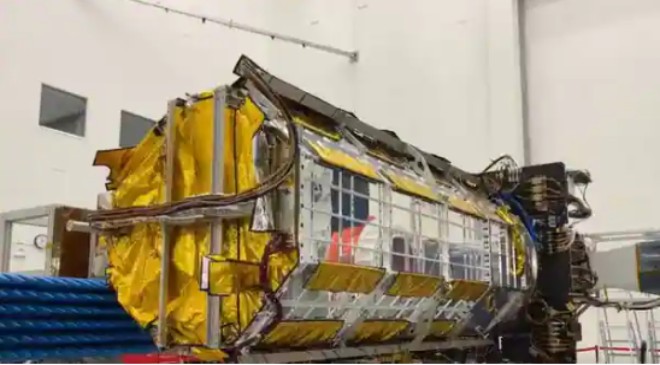NISAR which was jointly built by the National Aeronautics and Space Administration (NASA) and the Indian Space Research Organisation (ISRO), got send-off ceremony in California before it ships out to its last stop in India.
Also Read– U’khand’s Landslide Alert, UP Rains, Odisha’s Cold Wave: Many States Shiver as Mumbai Feels Humidity
Outside the facility, in front of a scale model of the NISAR satellite, NASA’s NISAR Project Manager Phil Barela and ISRO’s NISAR Project Director CV Shrikant ceremonially broke fresh coconuts. The tradition, common in India, often marks auspicious occasions and signifies hope for a smooth road ahead. Leshin also presented the ISRO delegation with a jar of JPL lucky peanuts.
ISRO Chairman S Somanath, Jet Propulsion Laboratory (JPL) Director Laurie Leshin, and dignitaries from NASA headquarters including Bhavya Lal, NASA’s associate administrator for technology, policy, and strategy were present at NASA’s Jet Propulsion Laboratory (JPL) for the send-off.
Read More: Will Yogi Adityanath Succeed PM Narendra Modi as Next Prime Minister? Uttar Pradesh CM Says This
“Today we come one step closer to fulfilling the immense scientific potential NASA and ISRO envisioned for NISAR when we joined forces more than eight years ago,” Somanath said.
“This mission will be a powerful demonstration of the capability of radar as a science tool and help us study Earth’s dynamic land and ice surfaces in greater detail than ever before,” he added.
“This marks an important milestone in our shared journey to better understand planet Earth and our changing climate,” JPL’s Leshin said.
“NISAR will provide critical information on Earth’s crust, ice sheets, and ecosystems. By delivering measurements at unprecedented precision, NISAR’s promise is a new understanding and a positive impact in communities. Our collaboration with ISRO exemplifies what’s possible when we tackle complex challenges together,” added Leshin.
Here’s all you need to know about NISAR:
NISAR mission, planned to launch in 2024, is expected to systematically map Earth, using two different radar frequencies to monitor resources such as water, forests and agriculture.
It will measure Earth’s changing ecosystems, dynamic surfaces, and ice masses providing information about biomass, natural hazards, sea level rise, and groundwater, and will support a host of other applications.
It will will observe Earth’s land and ice-covered surfaces globally with 12-day regularity on ascending and descending passes, sampling Earth on average every 6 days for a baseline 3-year mission.
Since early 2021, engineers and technicians at JPL have been integrating and testing NISAR’s two radar systems – the L-band SAR provided by JPL and the S-band SAR built by ISRO. JPL, which is managed for NASA by Caltech in Pasadena, leads the U.S. component of the project and is providing the mission’s L-band SAR.
Later this month, they will move the SUV-size payload into a special cargo container for a 9,000-mile (14,000-kilometer) flight to India’s U R Rao Satellite Centre in Bengaluru.
There it will be merged with the spacecraft bus in preparation for a 2024 launch from Satish Dhawan Space Centre in Andhra Pradesh state.
NISAR will gather radar data with a drum-shaped reflector antenna almost 40 feet (12 meters) in diameter.
It will use a signal-processing technique called interferometric synthetic aperture radar, or InSAR, to observe changes in Earth’s land and ice surfaces down to fractions of an inch.





































